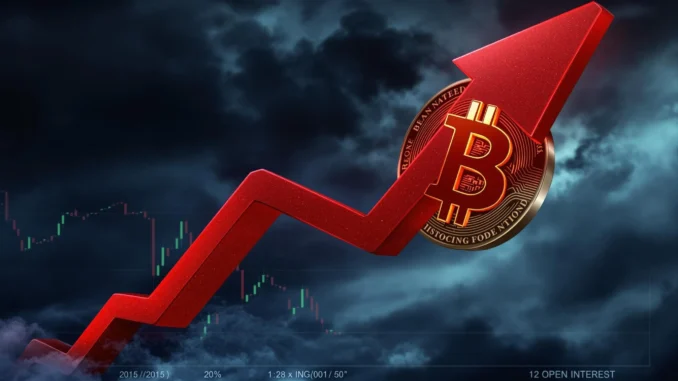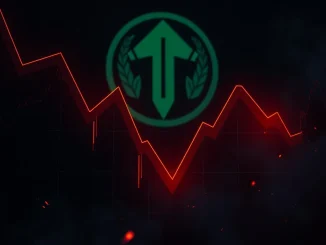
Hold onto your hats, crypto enthusiasts! The Bitcoin market is flashing some serious warning signs. Just when we thought we might see some stabilization, a new development has emerged that could point towards further price drops. What’s causing this unease in the market? It all boils down to a significant spike in Bitcoin open interest.
What Does the $1 Billion Surge in Bitcoin Open Interest Mean?
Let’s break down what’s happening. Imagine a crowded marketplace where traders are placing bets on the future price of Bitcoin using futures contracts. Bitcoin open interest represents the total number of outstanding futures contracts – essentially, the total value of all these bets that are currently open and active.
According to data from Coinglass, cited by CoinDesk, the Bitcoin open interest for the BTC/USDT pair on Binance has jumped by a whopping 12,000 BTC. At current prices, that’s over $1 billion! This massive increase occurred precisely as the BTC price decline from $96,000 to under $92,000. Think of it like this:
- Price Drops: Bitcoin’s price started falling.
- Open Interest Rises: Simultaneously, the number of open futures contracts increased dramatically.
This combination is a crucial indicator. Why? Because a rising Bitcoin open interest during a price fall often suggests a strengthening bearish sentiment. It implies that traders are opening more short positions – essentially betting that the price will continue to fall.
Digging Deeper: Bearish Signals in Crypto Market Analysis
But the story doesn’t end with just the open interest. Let’s delve into some additional crypto market analysis indicators that are reinforcing this bearish outlook:
Cumulative Volume Delta (CVD) Declines
The Cumulative Volume Delta (CVD) is a valuable tool for understanding buying and selling pressure in the market. A declining CVD indicates that sellers are more aggressive than buyers. In the case of Binance, the CVD has been decreasing, further confirming that selling pressure is dominating the market right now. This means:
- More Selling than Buying: Traders are selling off Bitcoin more aggressively than they are buying.
- Downward Pressure: This increased selling pressure is contributing to the BTC price decline.
Bearish Marubozu Candlestick Pattern
Technical analysts have also pointed to a bearish marubozu candlestick pattern that appeared on February 24th. Let’s decode this jargon:
- Candlestick Patterns: These are visual representations of price movements over a specific period.
- Marubozu: A marubozu candlestick has a large body and very small or no shadows (wicks).
- Bearish Marubozu (Red): A red marubozu indicates strong selling pressure throughout the period, with the price closing near the low.
The appearance of this bearish marubozu pattern suggests strong and sustained selling interest.
Key Moving Averages Act as Resistance
Moving averages are used to smooth out price data and identify trends. The 50-day and 100-day Simple Moving Averages (SMAs) are closely watched by traders. Currently, Bitcoin’s price remains below both of these key SMAs. This is significant because:
- Resistance Levels: These SMAs are now acting as resistance levels. Prices often struggle to break above resistance.
- Seller Confidence: Staying below these SMAs can embolden sellers, as it confirms the downtrend in their eyes.
Could This Bearish Bitcoin Signal Lead to Further Losses?
While no market prediction is ever guaranteed, the confluence of these bearish indicators – the surge in Bitcoin open interest, declining CVD, bearish candlestick patterns, and resistance from key moving averages – paints a concerning picture. Analysts suggest that these factors could indeed encourage further selling and lead to additional price losses in the short term.
Futures market data like open interest is a powerful tool for understanding market sentiment, but it’s crucial to remember that the cryptocurrency market is inherently volatile. Unexpected events, shifts in market sentiment, or broader economic factors can all influence price movements.
Navigating the Crypto Market Analysis in Bearish Times
So, what does this mean for you? Here are some actionable insights to consider as you navigate this potentially bearish phase in the crypto market:
- Stay Informed: Keep a close eye on crypto market analysis and data from reputable sources. Monitor open interest, CVD, and key technical indicators.
- Manage Risk: If you are trading, consider tightening your stop-loss orders to protect your capital in case of further price drops.
- Diversify: Don’t put all your eggs in one basket. Diversification can help mitigate risk in volatile markets.
- Long-Term Perspective: Remember that market cycles are a natural part of the crypto world. Bearish phases can be followed by bullish recoveries. Consider your long-term investment strategy and avoid making impulsive decisions based on short-term market fluctuations.
- Education is Key: Continuously learn about crypto market analysis, technical indicators, and risk management strategies to make more informed decisions.
Conclusion: A Cautious Outlook for Bitcoin Amid Rising Open Interest
The recent surge in Bitcoin open interest, coupled with other bearish signals, warrants caution in the crypto market. While the situation is dynamic and can change rapidly, the current indicators suggest a potential for further BTC price decline. By staying informed, managing risk effectively, and maintaining a long-term perspective, you can navigate these uncertain times and position yourself for future opportunities in the ever-evolving world of cryptocurrency. Keep a watchful eye on the market, and remember that knowledge and preparedness are your best assets in the crypto space.



